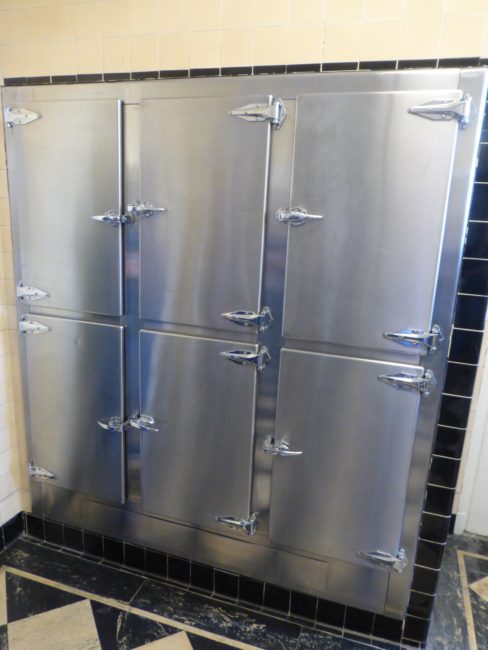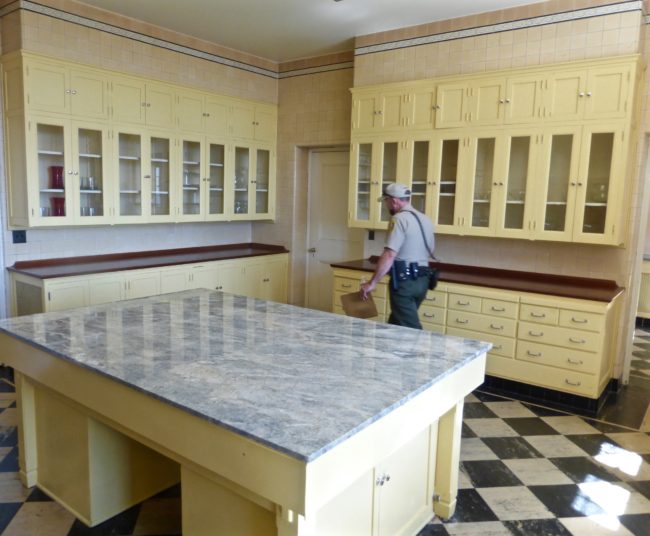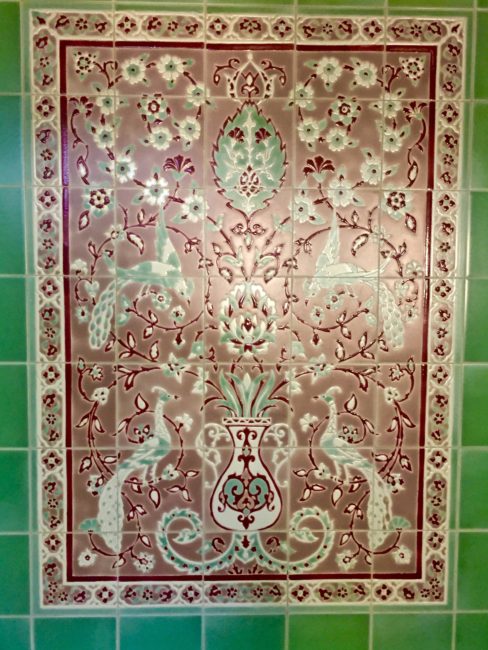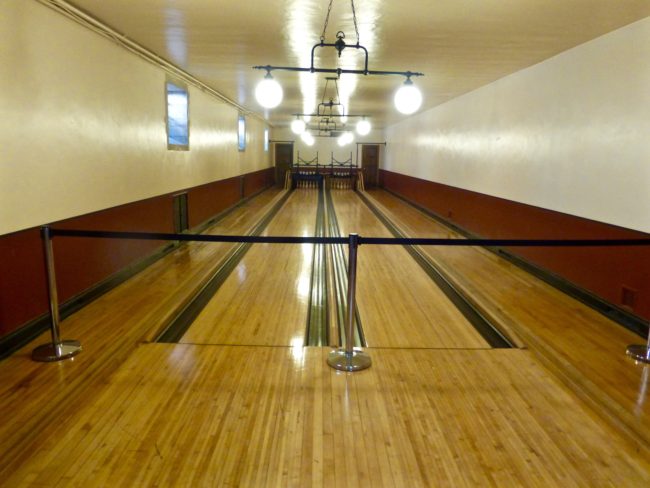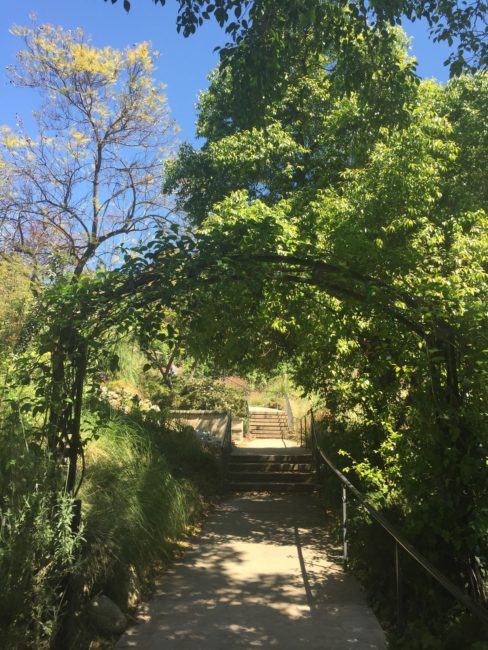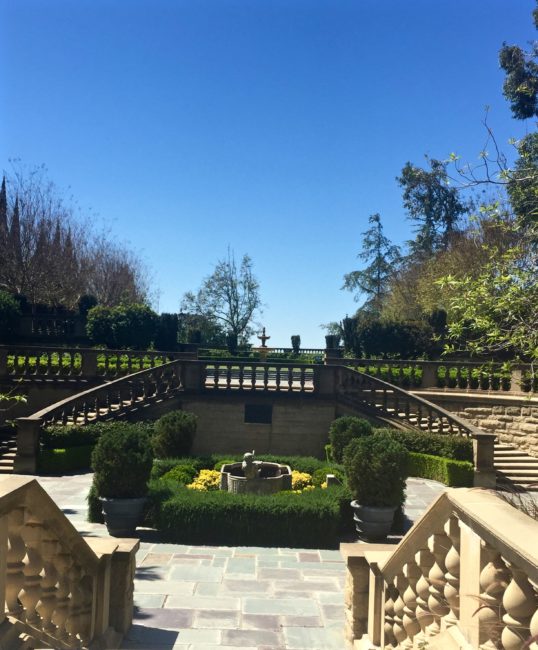
Los Angeles Police Museum – Los Angeles (Highland Park)
March 14, 2017
The Bunny Museum – Altadena
April 14, 2017Intrigue, Scandal, Ghosts & Deaths In The Mansion
 Greystone Mansion & Gardens – Beverly Hills
Greystone Mansion & Gardens – Beverly Hills
Visited: April 2017
Lights! Camera! Murder! The historic Greystone Mansion & Gardens, nestled above Beverly Hills, which is now primarily used for private events, weddings, and filming, has a history that includes scandals, at least six deaths and is even rumored to be haunted. In addition, it’s also been the venue for dozens of movies and television shows. My kind of place! (Two photos below are courtesy of the City of Beverly Hills.)
Tracy and I visited on April Fools Day and took the Ranger Tour. Throughout the years, I have found that the person who runs a tour can make or break your visit. Our ranger on this day did not disappoint. Our tour guide on this beautiful Saturday morning was the very personable and knowledgeable park ranger, Steve, who has been working on the estate for nearly 18 years. All we had to do was mind our Manors.
Oil tycoon, Edward Doheny (more on his fascinating and lurid history later), owned a country estate comprised of 420 acres in the hills above Beverly Hills. When his son, Edward Jr. (Ned), married Lucy, the couple lived nearby and eventually had five children. Living too close for comfort, Edward gifted a parcel to his son and in 1926 work on this magnificent home commenced. (Edward on the left and Ned on the right)
The 46,000 square foot home was finished in 1928 with construction costs of $3.2 million.
The home has concrete walls and was covered with hand carved limestone making the walls almost three feet thick.
The roof was also concrete and is covered with slate tiles imported from Wales (he must have been one of the first to save the Wales). The numerous brick chimneys are hand-carved. Solid lead rain gutters and leaded windows round out the attention to detail of this grand home.
One needs a European map to follow its architect because the mansion is reminiscent of a grand English manor, was designed by noted German architect, Gordon Cochran, who is known primarily for his Spanish-style designs.
In 1955, Ned’s widow subdivided the property and moved to a nearby parcel where she built a retirement home for herself. Greystone itself was sold for $2.6 million to a Midwest industrialist, Col. Henry Crown, who owned the Empire State Building. Upon hearing of the tragic history of the home (more death foreshadowing), his wife declined to move into the mansion, and it was abandoned for nearly ten years.
According to the city of Beverly Hills, “Crown never intended to live at Greystone. Instead, he rented the estate to movie studios. In 1963, he wanted to subdivide the property, which would have resulted in the mansion’s demolition.” A citizen’s committee was formed to save the mansion. “For two years, the City of Beverly Hills negotiated with Crown to purchase the estate. An agreement was reached on November 3, 1965, and the city purchased Greystone and the grounds for $1,100,000. The grounds were converted into a park and a site for a 19,300,000 gallon subsurface reservoir.”
On April 23, 1976, the Department of Interior’s National Register of Historic Places added the Greystone Mansion to its national registry. The parking lot at the mansion now covers the reservoir which is the largets in the city of Beverly Hills.
The mansion reverted back to the City in 1983 in terrible disrepair, and the City began a restoration project that costs about $1 to $2 million annually. Recently, the City added a modern catering facility to the tune of $1 million.
 The large residence overlooking the parking lot was originally the home of burlesque entertainer Gypsy Rose Lee, who probably had it stripped down.
The large residence overlooking the parking lot was originally the home of burlesque entertainer Gypsy Rose Lee, who probably had it stripped down.
We cued up Lynn Anderson…
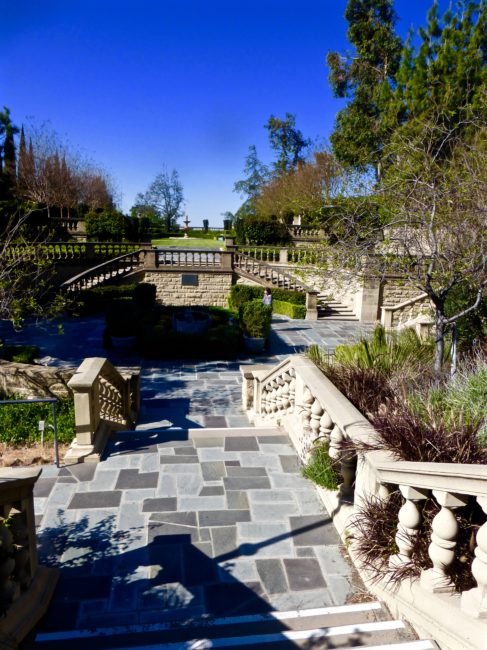 …and our tour started in the walled rose garden which is now the site of many weddings and private functions. Unfortunately, it was probably a week or two early to see the roses in bloom.
…and our tour started in the walled rose garden which is now the site of many weddings and private functions. Unfortunately, it was probably a week or two early to see the roses in bloom.
 There’s also a lovely fountain on the lawn.
There’s also a lovely fountain on the lawn.
Adjacent to the rose garden is what was formerly the pool (now literally a cement pond) with a lattice fronted pool house. Steve told us that musicians frequently played on the roof of the pool house, whose repertoire I assume included The Drifter’s Up On The Roof.
 The pool is located about a football field away from the main house, so the Doheny family had four chauffeurs on call to drive the family and their guests to the pool. Walking 300-feet in the old days must have been quite arduous for the rich.
The pool is located about a football field away from the main house, so the Doheny family had four chauffeurs on call to drive the family and their guests to the pool. Walking 300-feet in the old days must have been quite arduous for the rich.
Speaking of large residences, there is a white monstrosity seen from the pool area that mars the entire hillside. Mrs. Doheny’s “retirement” home was sold for $46 million to a tool magnate, who tore it down and over the next seven years built an 82,000 square-foot residence. It looks like someone parked the Queen Mary in the neighborhood.
 Soon we wandered into Cypress Lane. The Italian cypresses are under-planted with lavender, which was blooming on this glorious April Fools Day morning.
Soon we wandered into Cypress Lane. The Italian cypresses are under-planted with lavender, which was blooming on this glorious April Fools Day morning.
One side of the lane is lined with gargoyle fountains, each with a different face.
The exterior tour of the mansion started outside in front of the former fire station.
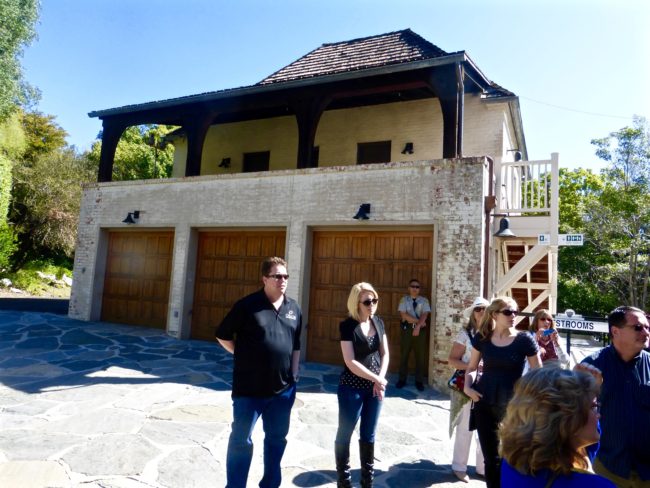 We entered into the circular courtyard through the arched entryway that was used for delivery persons.
We entered into the circular courtyard through the arched entryway that was used for delivery persons.
We meandered past a rectangular pond.
 Walking around the mansion’s exterior…
Walking around the mansion’s exterior…
 …we looked up to see those beautifully carved chimneys, each with a different design because the family couldn’t settle on just one pattern. The ranger explained that these chimneys, although not secured, have survived all the major earthquakes in Los Angeles since the house was built.
…we looked up to see those beautifully carved chimneys, each with a different design because the family couldn’t settle on just one pattern. The ranger explained that these chimneys, although not secured, have survived all the major earthquakes in Los Angeles since the house was built.
Near the chimneys were giant lights that were turned on to alert police something nefarious might be going on at the mansion. Our ranger, who could be a Joker on occasion, told us that these lights were the inspiration for the Bat-Signal.
There were some nice views of Los Angeles and the grounds from this area, although the day was a little hazy. Now, it was time to step inside.
Entering the foyer with marble steps and a crystal chandelier…
…we witnessed the intricate designs of the woodwork, also all hand-carved.
Next, we found ourselves in a light-filled room overlooking the city that was used as the card room. Being the card room, I was perplexed there wasn’t a deck. However, I dealt with that and shuffled on.
 The view back toward the entry was beautiful from this vantage point across the Grand Hall.
The view back toward the entry was beautiful from this vantage point across the Grand Hall.
 We walked through the checkered marble hallway in the Grand Hall.
We walked through the checkered marble hallway in the Grand Hall.
 Each room has a picture of the home as it appeared when the family moved in in 1928 and also how it looked after Mrs. Doheny redecorated in 1945. Steve said they are fortunate to have so many photos of the interior as the home was featured in Architectural Digest.
Each room has a picture of the home as it appeared when the family moved in in 1928 and also how it looked after Mrs. Doheny redecorated in 1945. Steve said they are fortunate to have so many photos of the interior as the home was featured in Architectural Digest.
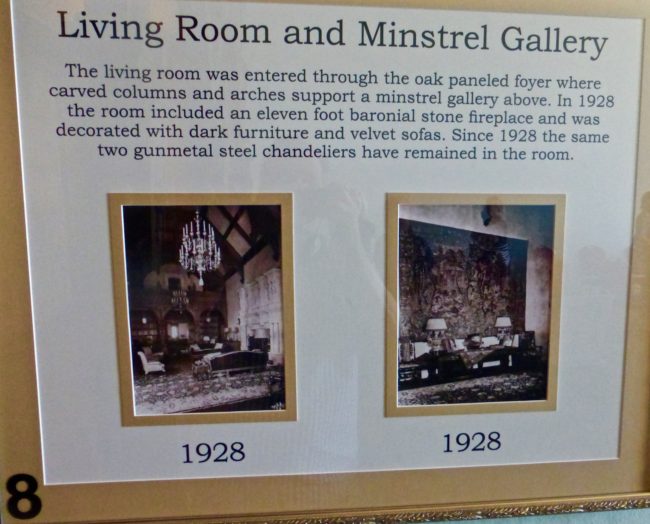 Unfortunately for the house, when Mrs. Doheny re-decorated, she had all the woodwork painted turquoise, which would make any preservationist blue. The city has spent hundreds of thousands of dollars removing the paint and restoring the woodwork.
Unfortunately for the house, when Mrs. Doheny re-decorated, she had all the woodwork painted turquoise, which would make any preservationist blue. The city has spent hundreds of thousands of dollars removing the paint and restoring the woodwork.
They rolled out the Barrel vaulted beamed ceiling in the Grand Salon Ballroom.
 At other points in the house, we saw the light.
At other points in the house, we saw the light.
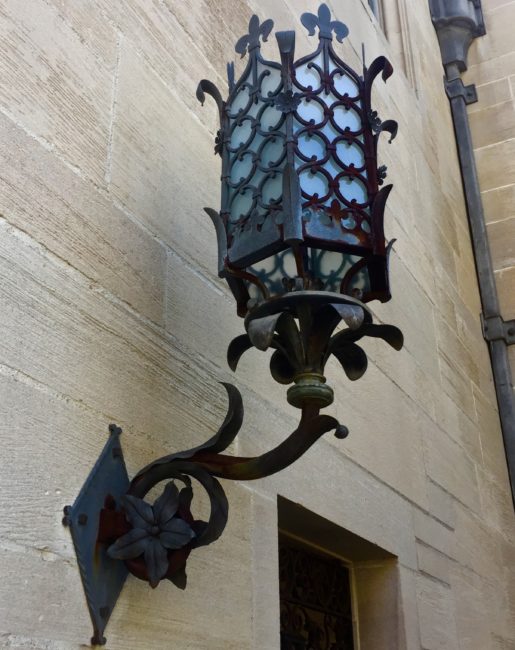 We moved along to the Living Room and Minstrel Gallery where Ranger Steve regaled us with the history of the Doheny family as we took in the beauty of the room.
We moved along to the Living Room and Minstrel Gallery where Ranger Steve regaled us with the history of the Doheny family as we took in the beauty of the room.
We learned Dark Side of Fortune is required reading for all rangers. We also were interested in finding out that the movie, There Will Be Blood was based on the life of Edward Doheny. Daniel Day-Lewis won an Oscar for his portrayal of Doheny. Unfortunately, milkshakes were not provided.
 Ranger Steve’s history lesson was one of the highlights of the tour. Briefly, Edward Doheny (the elder) got a late start amassing his fortune. He moved to California with his wife and frail daughter when he was 40. Up until that time, Doheny made ends meet by playing cards (he was very good at counting cards). One day he was sitting on the porch when he noticed that a tarry pitch was sticking to the wheels of carriages and carts in the city. He traced it to a center of oil seepage near Westlake Park.
Ranger Steve’s history lesson was one of the highlights of the tour. Briefly, Edward Doheny (the elder) got a late start amassing his fortune. He moved to California with his wife and frail daughter when he was 40. Up until that time, Doheny made ends meet by playing cards (he was very good at counting cards). One day he was sitting on the porch when he noticed that a tarry pitch was sticking to the wheels of carriages and carts in the city. He traced it to a center of oil seepage near Westlake Park.
He inquired about the contents which got him thinking about drilling for oil. He managed to gather enough funds to purchase a small plot of land and began digging a well by hand. By the time he finally hit oil, his daughter had passed away, and he had grown estranged from his wife. Although estranged, the couple found time to conceive a son, Ned, who was born shortly after striking oil, but as you will find out, all’s well that didn’t end well.
Edward was very successful at finding oil and in 1915 struck the biggest oil gusher ever. It was so big that Jed Clampett would have been envious.
The gusher rose 600 feet in the air and took two weeks to cap off. The oil ran waist deep in a two-mile radius, which I’m sure kept dry cleaners in the area busy. This particular well produced 260,000 barrels of oil a day and made Edward one of the richest men in the world. Doheny ensured he would never run out of money or customers by convincing the Santa Fe Railroad to convert its trains from coal to oil. Other railroad companies soon followed suit.
In the interim, Mrs. Doheny (Carrie Louella) moved to San Francisco with their son and soon after requested a divorce. Within a week, Edward remarried a much younger woman, a telephone operator. Mrs. Doheny became so distraught she killed herself by drinking an entire bottle of battery acid. The death was investigated as a possible murder as the coroner did not believe someone could drink a whole bottle of battery acid; not to mention, many thought Edward wanted a fresh start with his new wife and custody of young Ned. The death was eventually ruled a suicide, but this suicide was not painless.
We next learned a bit about the Teapot Dome Scandal. Edward was charged with bribery in the scandal and was set to go to trial in 1929. The only prosecution witnesses were Ned and his male secretary, Hugh, who happened to live at the mansion (it is widely presumed Ned was bisexual). One evening while Ned’s wife was in the room next door, Ned and his secretary were both shot dead in the secretary’s bedroom.
 The family covered up the deaths and did not even call the police for almost two hours. Ned’s wife first testified that she did not hear anything unusual and then changed her story that she just thought some furniture had been overturned but did not look for the source of the noise. The murders remain unsolved to this day, although in 1934 forensic investigator Leslie White, who doubted the pat story of murder-suicide, wrote a book, “Me Detective,” in which he lays out his theory that Edward was complicit in the murders.
The family covered up the deaths and did not even call the police for almost two hours. Ned’s wife first testified that she did not hear anything unusual and then changed her story that she just thought some furniture had been overturned but did not look for the source of the noise. The murders remain unsolved to this day, although in 1934 forensic investigator Leslie White, who doubted the pat story of murder-suicide, wrote a book, “Me Detective,” in which he lays out his theory that Edward was complicit in the murders.
By the way, a jury acquitted Edward Doheny in the Teapot Dome Scandal (the only one of the “Big Three” to get off…Albert Fall, Harry Sinclair, and Edward) because they felt he “had suffered enough.” It’s good to be rich.
 Secretary of the Interior Albert Fall, who leased the land to oil executives who had bribed him, became the first cabinet member ever to be imprisoned. I guess somebody had to be the “Fall guy.”
Secretary of the Interior Albert Fall, who leased the land to oil executives who had bribed him, became the first cabinet member ever to be imprisoned. I guess somebody had to be the “Fall guy.”
 We quickly visited the room that was the “scene of the crime.”
We quickly visited the room that was the “scene of the crime.”
 In what could be considered an oxymoron, Edward was an Irish teetotaler who did not allow any drinking around him. His son, however, took up the slack. Ned loved his liquor as evidenced by the secret panels throughout the home housing liquor cabinets.
In what could be considered an oxymoron, Edward was an Irish teetotaler who did not allow any drinking around him. His son, however, took up the slack. Ned loved his liquor as evidenced by the secret panels throughout the home housing liquor cabinets.
 We moved along through more rooms, many of which are recognizable from film and TV. The Breakfast Room was Lebowski’s office in 1998’s The Big Lebowski starring Jeff Bridges and John Goodman. “The Dude” was nowhere to be seen.
We moved along through more rooms, many of which are recognizable from film and TV. The Breakfast Room was Lebowski’s office in 1998’s The Big Lebowski starring Jeff Bridges and John Goodman. “The Dude” was nowhere to be seen.
 The Breakfast Room windows stood out…
The Breakfast Room windows stood out…
 The butler’s pantry often served as a morgue in many shows including Columbo and Murder She Wrote. As we saw, trouble was afoot, although I heard this guy was kind of a heel. This tour kept us on our toes.
The butler’s pantry often served as a morgue in many shows including Columbo and Murder She Wrote. As we saw, trouble was afoot, although I heard this guy was kind of a heel. This tour kept us on our toes.
The kitchen has been used in numerous movies, including Witches of Eastwick, The Bodyguard and Spider-Man 3. The stove was pretty cool, too.
After Ned’s untimely death, his widow remarried a friend from the Bay Area, Leigh Battson. This was a marriage of convenience as she needed someone to help with the estate and to raise her five children, and Battson wanted a high profile marriage with lots of money. It turns out he was allegedly taking advantage of the women staff, eventually causing three of them to commit suicide.
Battson also liked to hunt. Battson’s room was in the front of the house from where he and his friends could lean off the balcony and shoot the wildlife and birds below (how sporting!). Speaking of There Will Be Blood, his room had a connecting kitchen with a grooved counter for cleaning his prey.
 This hallway was quite reminiscent of The Shining. “Heeere’s Johnny!” We looked for some red rum and pressed on.
This hallway was quite reminiscent of The Shining. “Heeere’s Johnny!” We looked for some red rum and pressed on.
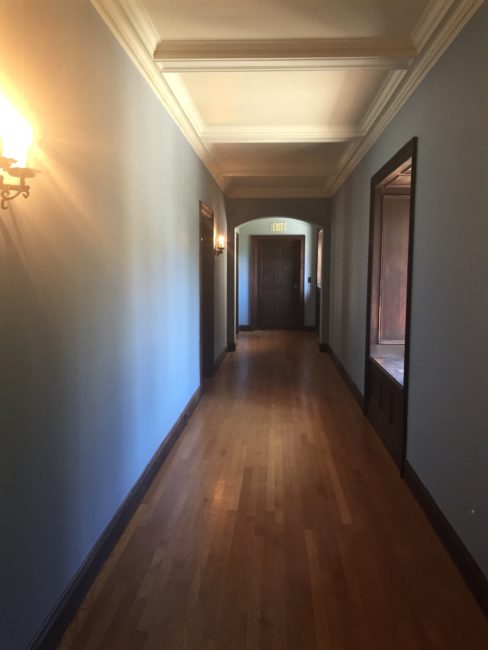 Next, we went through the children’s rooms. When they were young, each of the boys shared a room with connecting bathrooms which all appear to have their original tile work.
Next, we went through the children’s rooms. When they were young, each of the boys shared a room with connecting bathrooms which all appear to have their original tile work.
We loved the built-in scales, but since I was not dieting, I didn’t get on.
Note the beautiful ironwork over each shower enclosure.
 All the bathrooms were quite colorful.
All the bathrooms were quite colorful.
Ned’s daughter had her own room. Death didn’t escape this area either. She frequently had little friends stay over. In 1936, during the night, one of her friends fell out of the bedroom window to her death.
 It was in the daughter’s room that Steve discussed ghosts. Paranormal scientists have investigated the house on many occasions. Steve said that on a scale of 1 to 10, Greystone is a 15. Two rangers have quit because of their paranormal experiences at the mansion. Steve then played a tape of an incident that occurred during the filming of National Treasure: Book of Secrets.
It was in the daughter’s room that Steve discussed ghosts. Paranormal scientists have investigated the house on many occasions. Steve said that on a scale of 1 to 10, Greystone is a 15. Two rangers have quit because of their paranormal experiences at the mansion. Steve then played a tape of an incident that occurred during the filming of National Treasure: Book of Secrets.
One evening after shooting, the sound man decided to leave his equipment on all night to see if they could catch anything on tape. Sure enough, in the middle of the night, there was a loud noise (gunshot?), followed by something tipping over and the sound of something being dragged across the floor. When Steve and the crew returned the next morning, there was no evidence of anything untoward, and neither the alarm nor the set had been disturbed. At this point, I put Dan Ackroyd and Bill Murray on speed dial.
 We checked out the Dohenys’ adjoining bedrooms including Mrs. Doheny’s walk-in closet with jewel and fur safes.
We checked out the Dohenys’ adjoining bedrooms including Mrs. Doheny’s walk-in closet with jewel and fur safes.
 As we passed through the upper landing on our way downstairs, we noticed a large light fixture swinging from the ceiling. Earthquake? No. One of the rangers said the windows were open, so it was most likely wind, but it was a really big fixture, and no wind could be felt moving across the space. I looked around for Rod Serling.
As we passed through the upper landing on our way downstairs, we noticed a large light fixture swinging from the ceiling. Earthquake? No. One of the rangers said the windows were open, so it was most likely wind, but it was a really big fixture, and no wind could be felt moving across the space. I looked around for Rod Serling.
 We walked downstairs into the original (and rather spooky) screening room which is awaiting restoration. They need about 2.5 million dollars. Luckily, I forgot my checkbook.
We walked downstairs into the original (and rather spooky) screening room which is awaiting restoration. They need about 2.5 million dollars. Luckily, I forgot my checkbook.
 Our final stops of the tour included the bowling alley and the pool room. Right on cue, our ranger told us the pool table was recently donated by the Doheny family and is original to the mansion. While in the pool room, Steve showed us a hidden Prohibition-style bar, while I contemplated a Gin Fizz.
Our final stops of the tour included the bowling alley and the pool room. Right on cue, our ranger told us the pool table was recently donated by the Doheny family and is original to the mansion. While in the pool room, Steve showed us a hidden Prohibition-style bar, while I contemplated a Gin Fizz.
Since we had time to spare, we rolled into the adjacent Bowling Alley, although “The Dude” didn’t show up here either. Ranger Steve showed us how the ball return worked. This was life in the fast lane. I wondered if there had been a murder there, “Who would they pin it on?”
Then we were shown the scoreboard designating “Innings” instead of “Frames.” Since the bowling alley was our last stop, everybody split, but before that, we all agreed the tour had bowled us over.
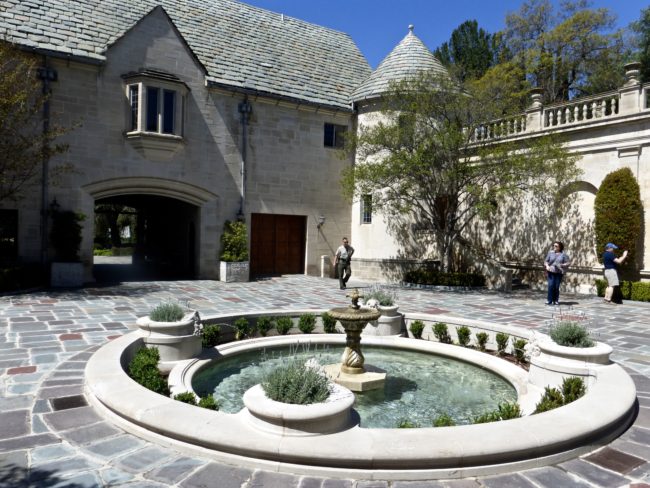 While leaving the grounds, we spotted Les Jardin De Paix.
While leaving the grounds, we spotted Les Jardin De Paix.
Then we took one last look at the Italianate stone balustrade…
…that leads up to the finely manicured mansion garden…
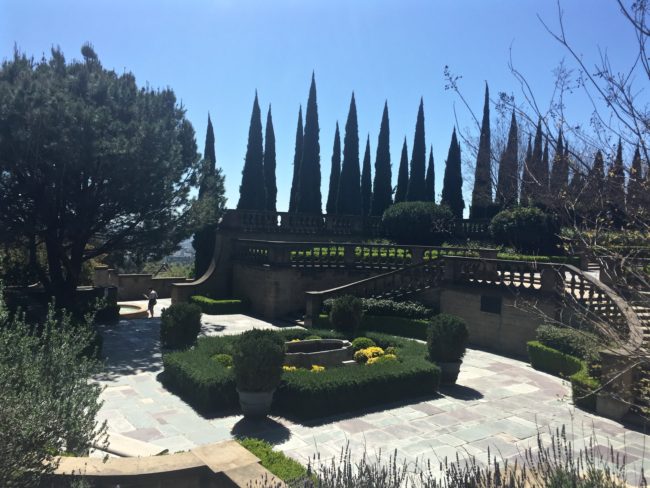 …said goodbye to our little friend and headed back to the parking lot.
…said goodbye to our little friend and headed back to the parking lot.
 In the two-hour tour, we walked a little more than a mile, and the 15 buck entrance fee is a bargain in our opinion. The ranger told us about a dinner held at Greystone Mansion each January recounting all the deaths that have occurred at the manor. I’d kill to go to that.
In the two-hour tour, we walked a little more than a mile, and the 15 buck entrance fee is a bargain in our opinion. The ranger told us about a dinner held at Greystone Mansion each January recounting all the deaths that have occurred at the manor. I’d kill to go to that.
Greystone offers Ranger Tours of the mansion on specific Saturdays from December through April, but reservations are required and limited to 20 people maximum, so its best to check their website and book early.
If you happen to be in Los Angeles between December and April, Tracy and I highly recommend taking the Ranger Tour. April would be the best, in our opinion, as the flowers are more colorful at that time. The gardens are open throughout the year, but check the website before coming, because the mansion hosts special events that could preclude your visiting on certain days. And keep a look out for those ghosts.
Greystone Mansion
905 Loma Vista Drive
Beverly Hills, CA 90210
Hours: 10 a.m. – 6 p.m. (Daylight Savings) until 5 p.m. (Pacific Standard Time)
Ranger Tour Price: $15
Garden Visits: Free
Visiting: The grounds are open to the public for self-guided visits. The mansion is only open during special programs such as Music In The Mansion and Friends Of Greystone events. Park ranger tours of the mansion and gardens are held on the first Saturday of the month December through April. Public restrooms are located in the original firehouse near the mansion. Due to the historic nature of the gardens, no picnicking or animals are allowed. Smoking is prohibited in all areas of the park (including the parking lot).
www.greystonemansion.org/



































